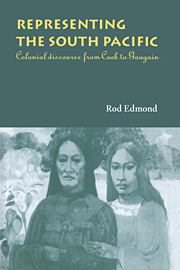Book contents
- Frontmatter
- Contents
- List of illustrations
- Acknowledgements
- 1 Introduction
- 2 Killing the god: the afterlife of Cook's death
- 3 Mutineers and beachcombers
- 4 Missionary endeavours
- 5 Trade and adventure
- 6 Taking up with kanakas: Robert Louis Stevenson and the Pacific
- 7 Skin and bones: Jack London's diseased Pacific
- 8 The French Pacific
- 9 Epilogue
- Notes
- Index
2 - Killing the god: the afterlife of Cook's death
Published online by Cambridge University Press: 31 October 2009
- Frontmatter
- Contents
- List of illustrations
- Acknowledgements
- 1 Introduction
- 2 Killing the god: the afterlife of Cook's death
- 3 Mutineers and beachcombers
- 4 Missionary endeavours
- 5 Trade and adventure
- 6 Taking up with kanakas: Robert Louis Stevenson and the Pacific
- 7 Skin and bones: Jack London's diseased Pacific
- 8 The French Pacific
- 9 Epilogue
- Notes
- Index
Summary
‘A schooner captain had told him [Tembinok of Apemama] of Captain Cook; the king was much interested in the story; and turned for more information … to the Bible in the Gilbert Island version … Paul he found, and Festus, and Alexander the copper-smith: no word of Cook. The inference was obvious: the explorer was a myth.’
(R. L. Stevenson, In the South Seas, part 4, ch. 4)Captain Cook was killed at Kealakekua Bay on the island of Hawai'i on 14 February 1779. News of his death reached England almost a year later, having travelled overland from Kamchatka in the Arctic circle of the Pacific to London where it was received on 11 January. The Gentleman's Magazine for that month carried Captain Clerke's report that Cook and four mariners had been killed ‘in an affray with a numerous and tumultuous body of the natives’. It went on to compare him with Magellan, killed by natives in the Philippine Islands in 1521, but also drew a contrast which was to be repeated in written and other representations of Cook from that time on:
in this he [Magellan] widely differed from our great countryman, that he was the aggressor, in endeavouring to extort tribute for his master the King of Spain; but Captain Cook was on the defensive, and in this, as a voyager, was almost singular, that he never knowingly injured, but always studied to benefit the savages whom he visited. […]
- Type
- Chapter
- Information
- Representing the South PacificColonial Discourse from Cook to Gauguin, pp. 23 - 62Publisher: Cambridge University PressPrint publication year: 1997



